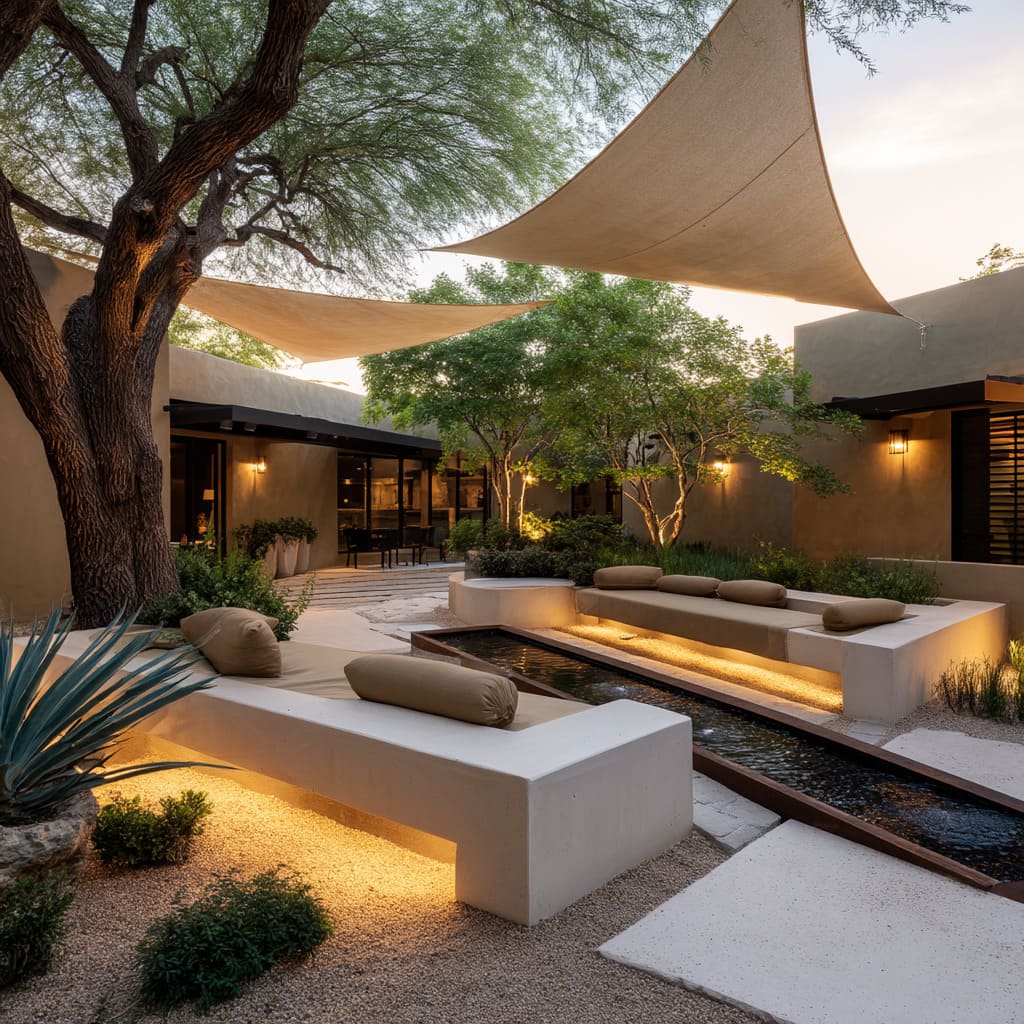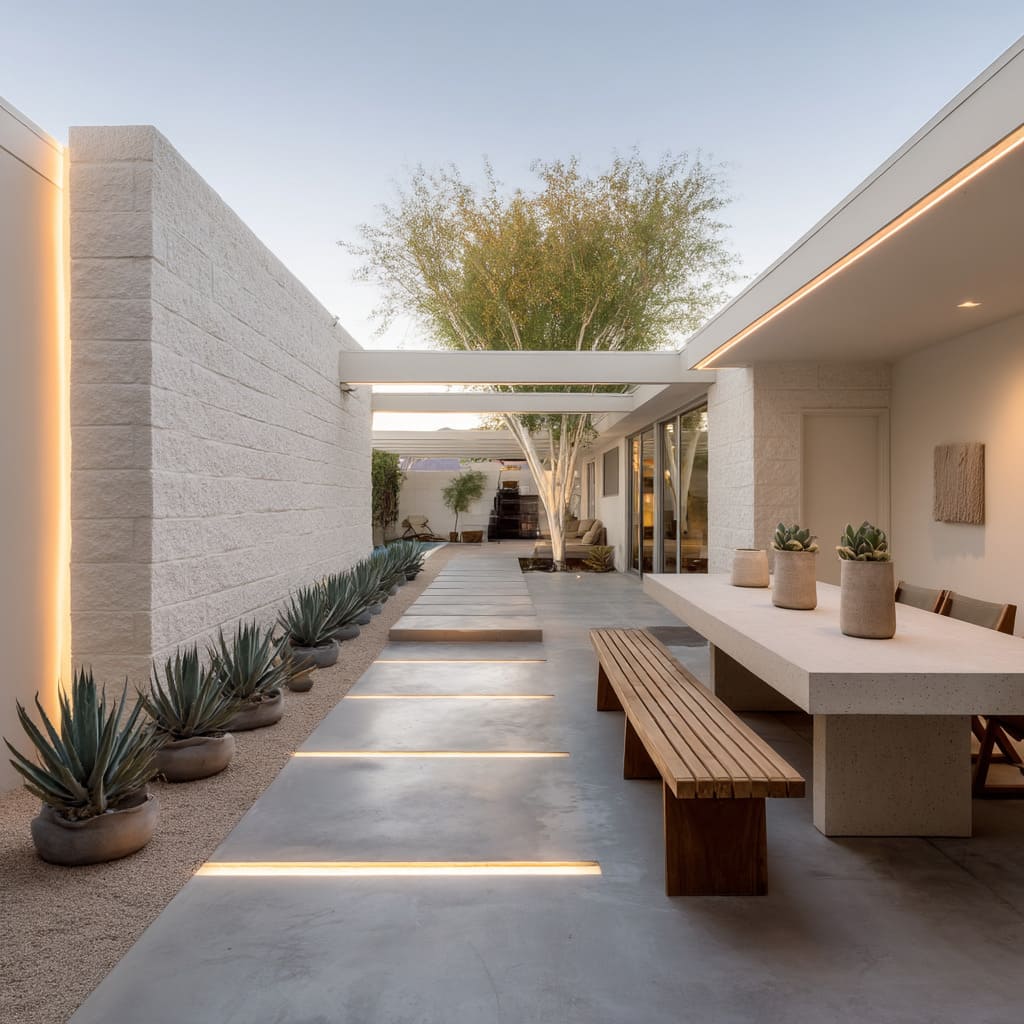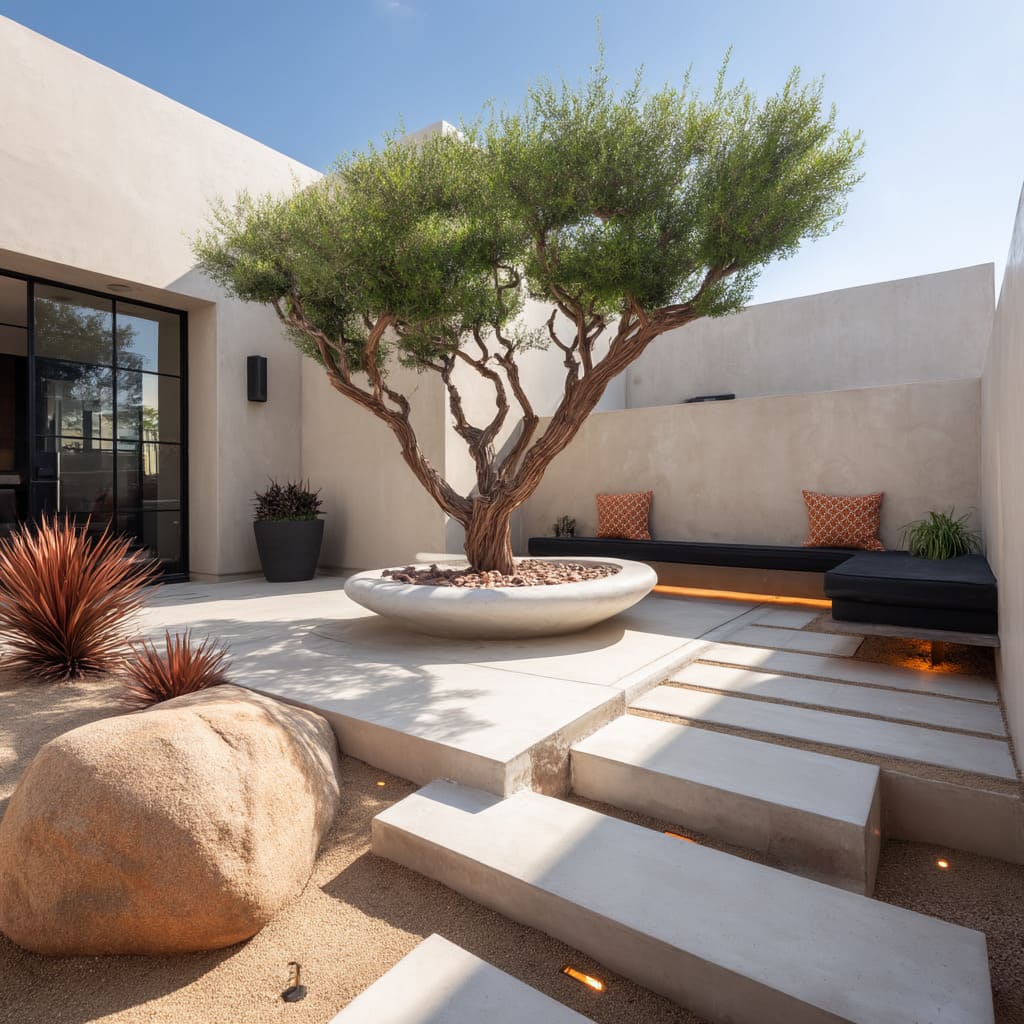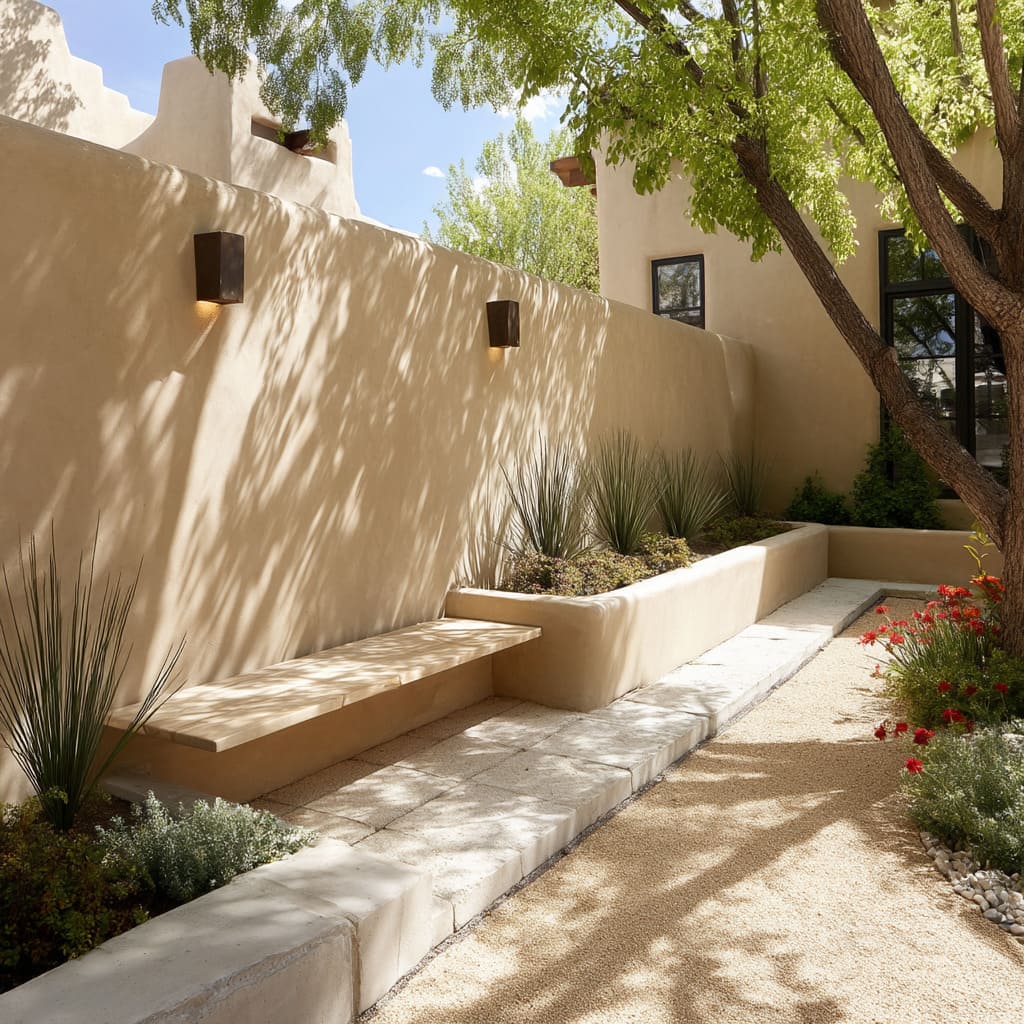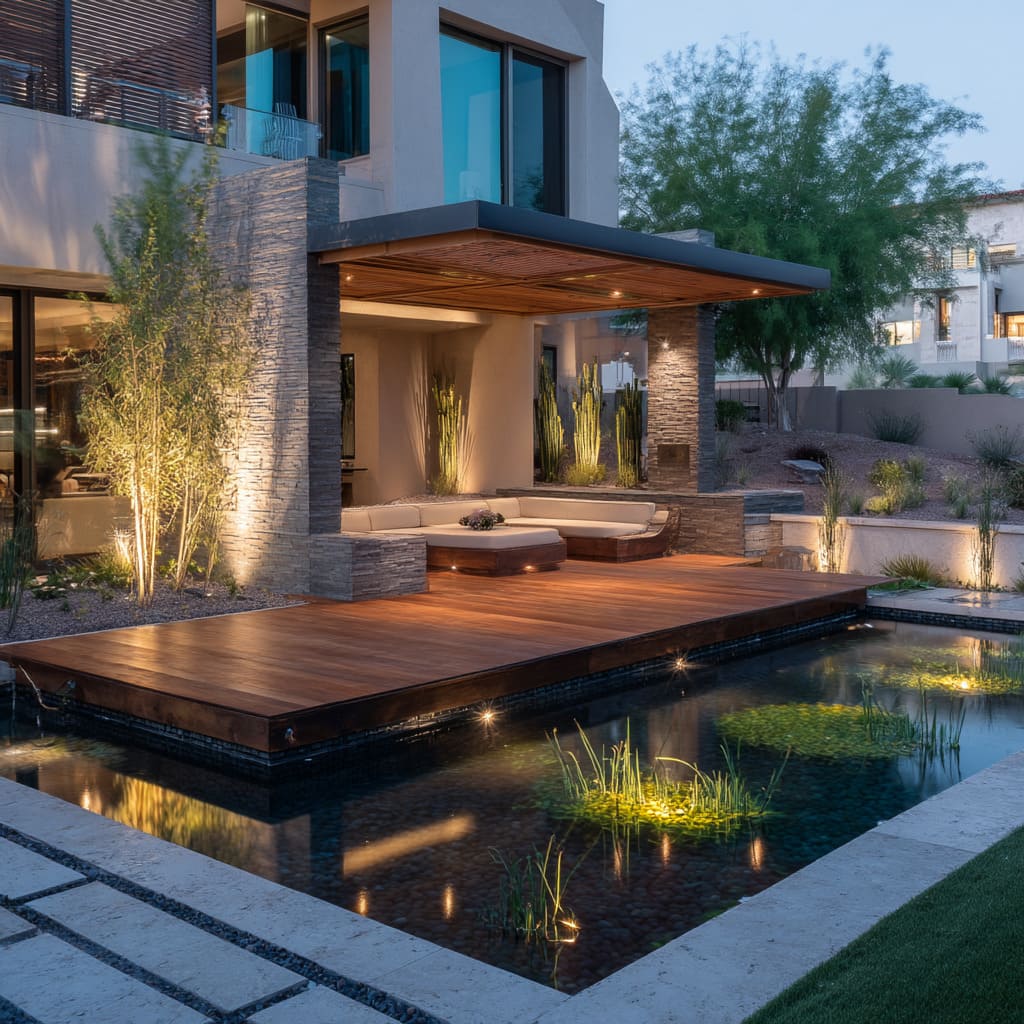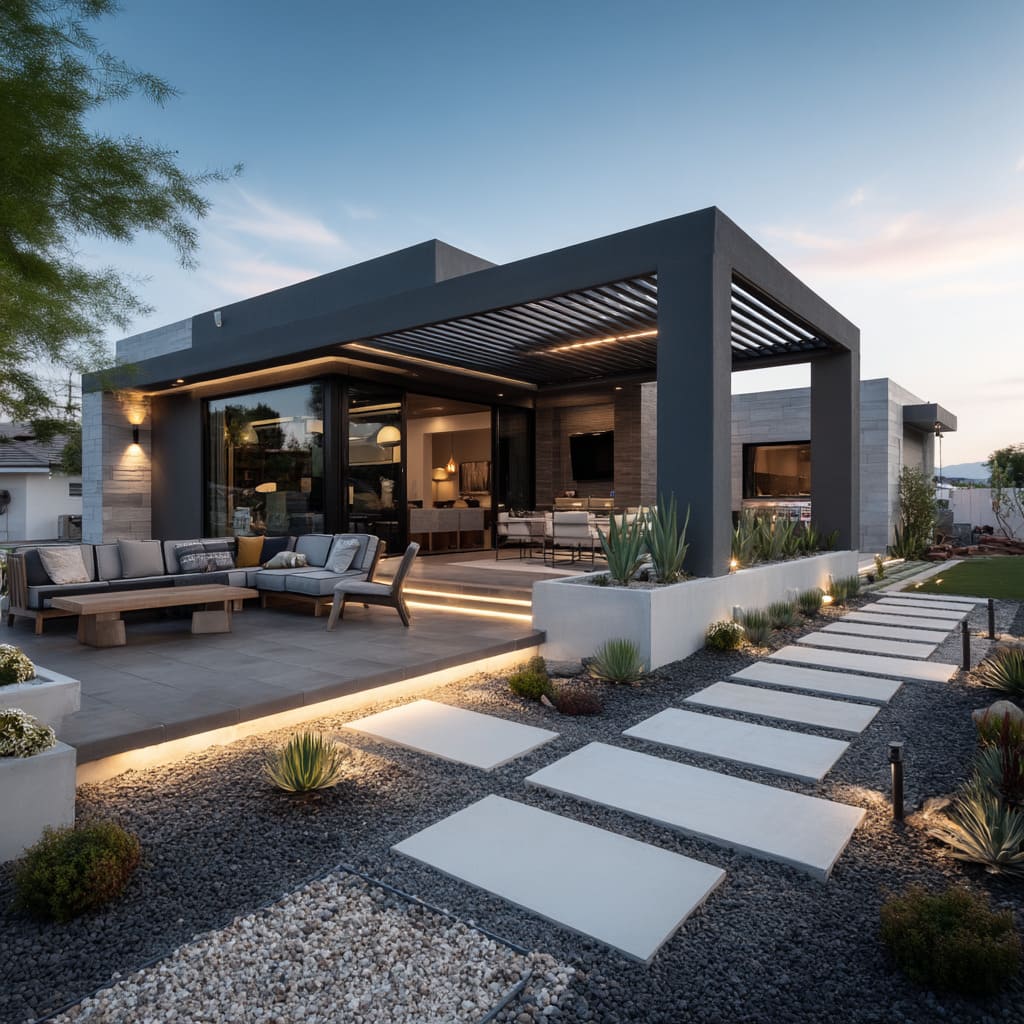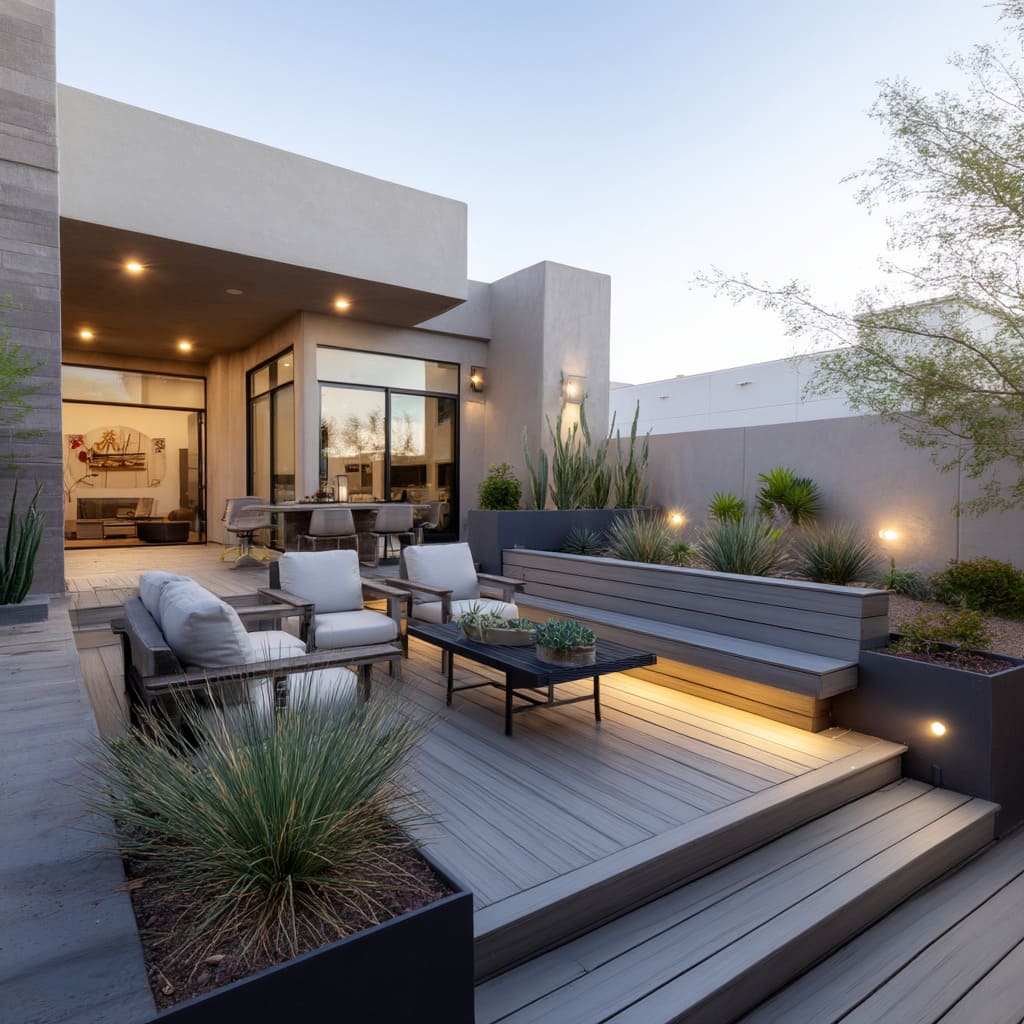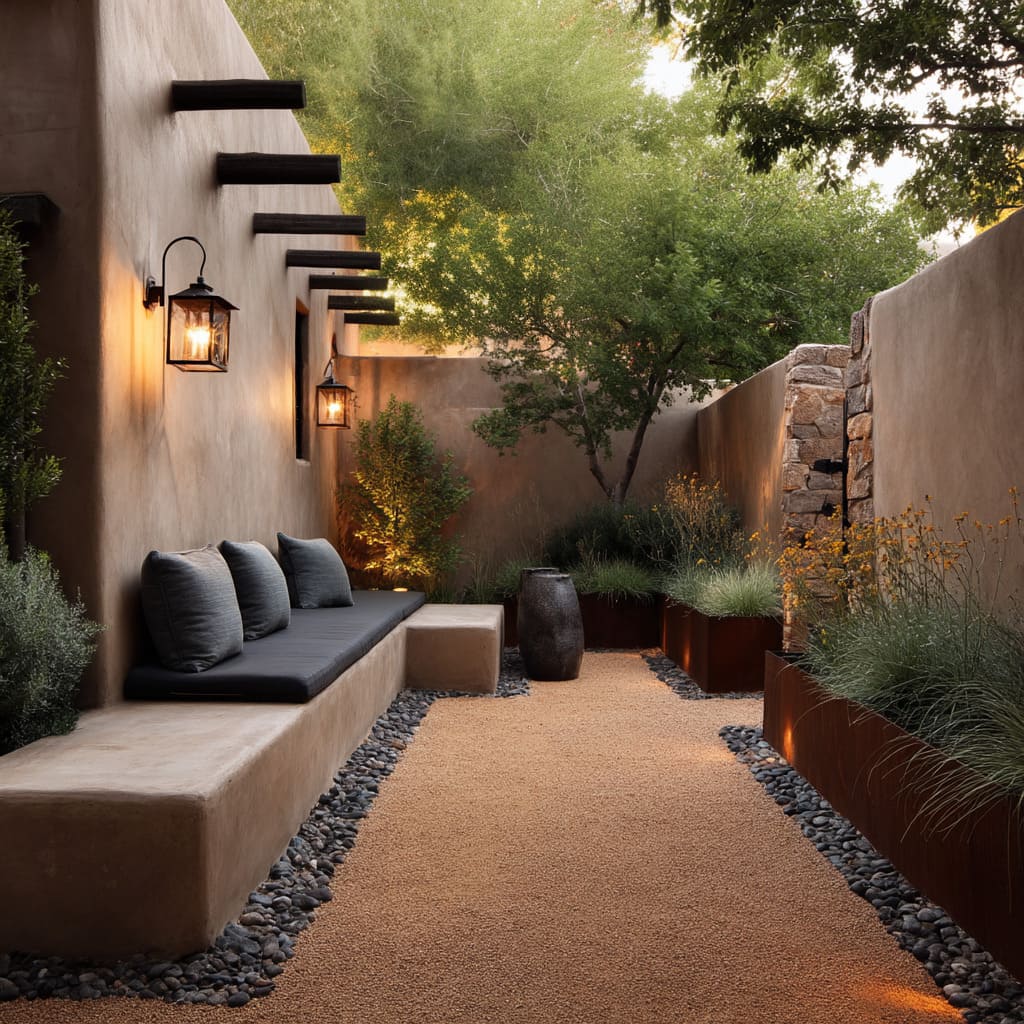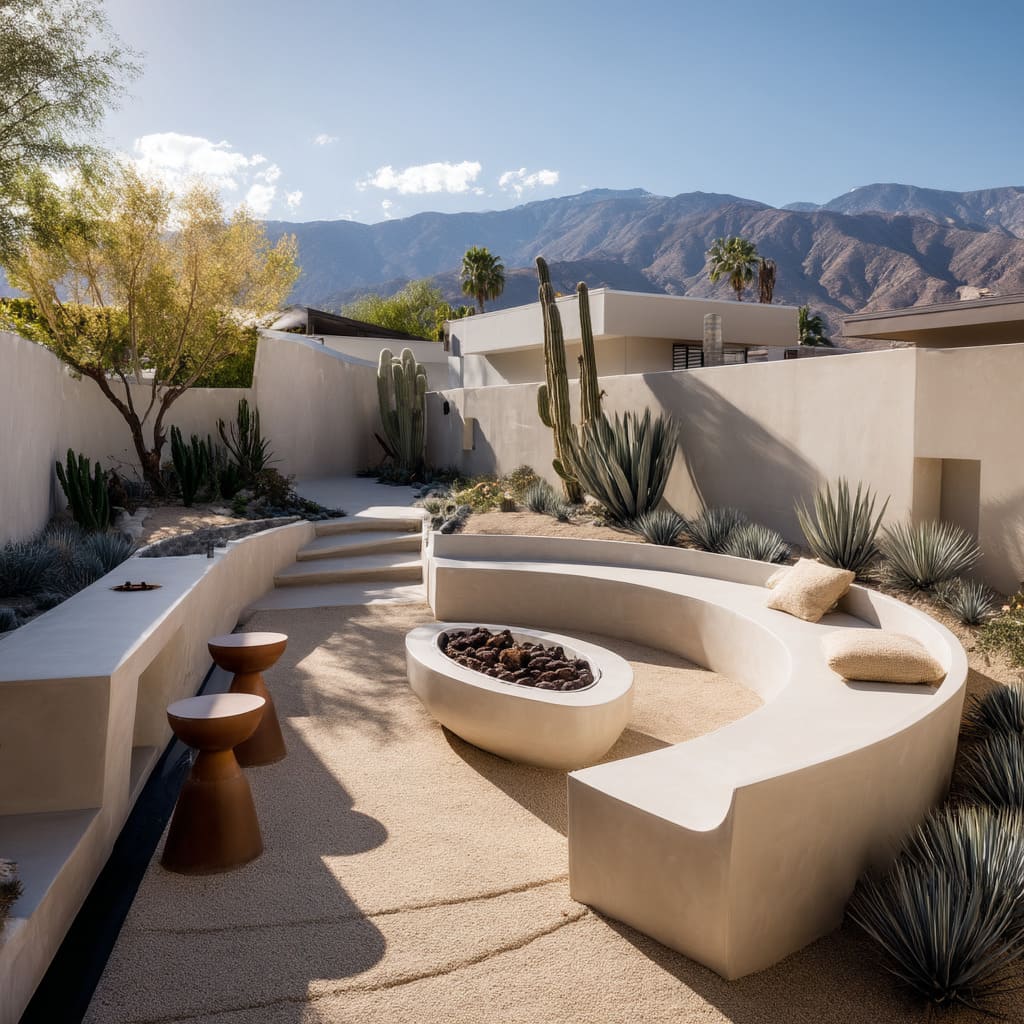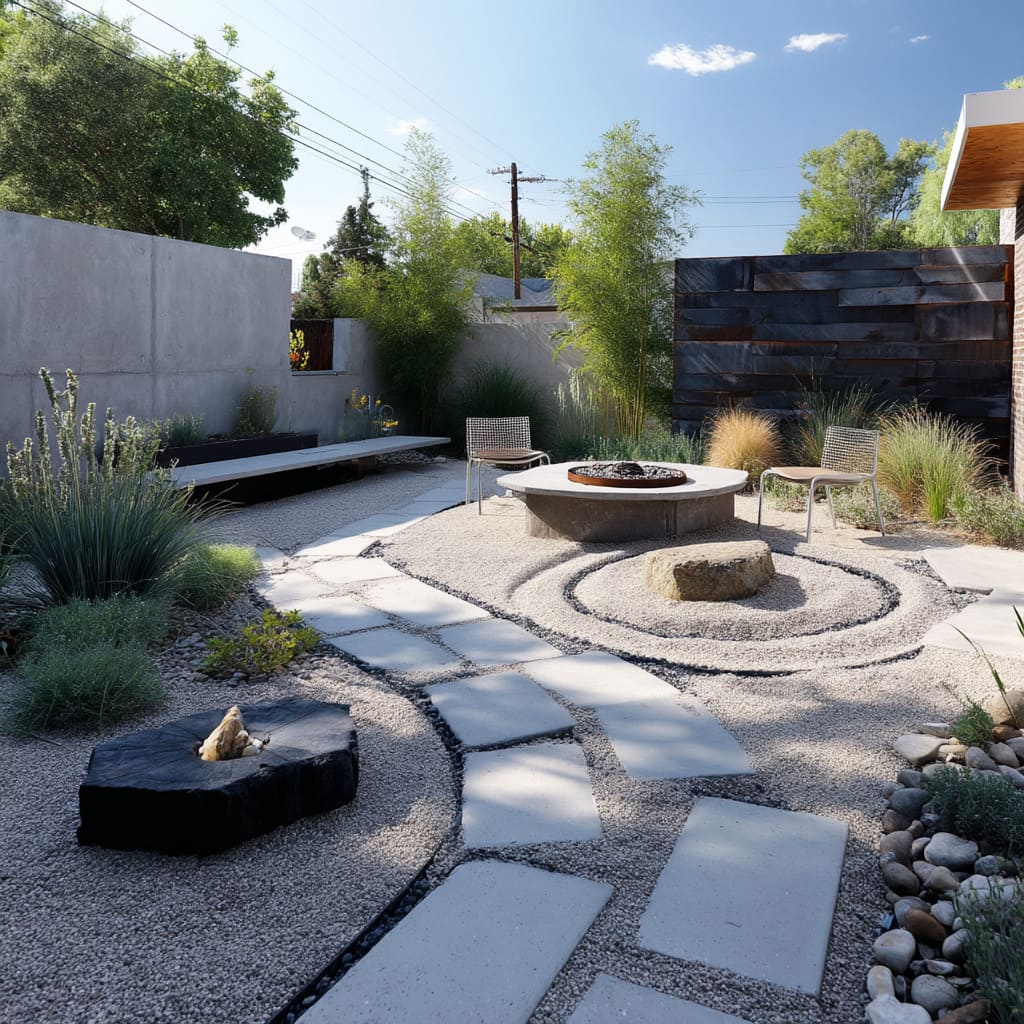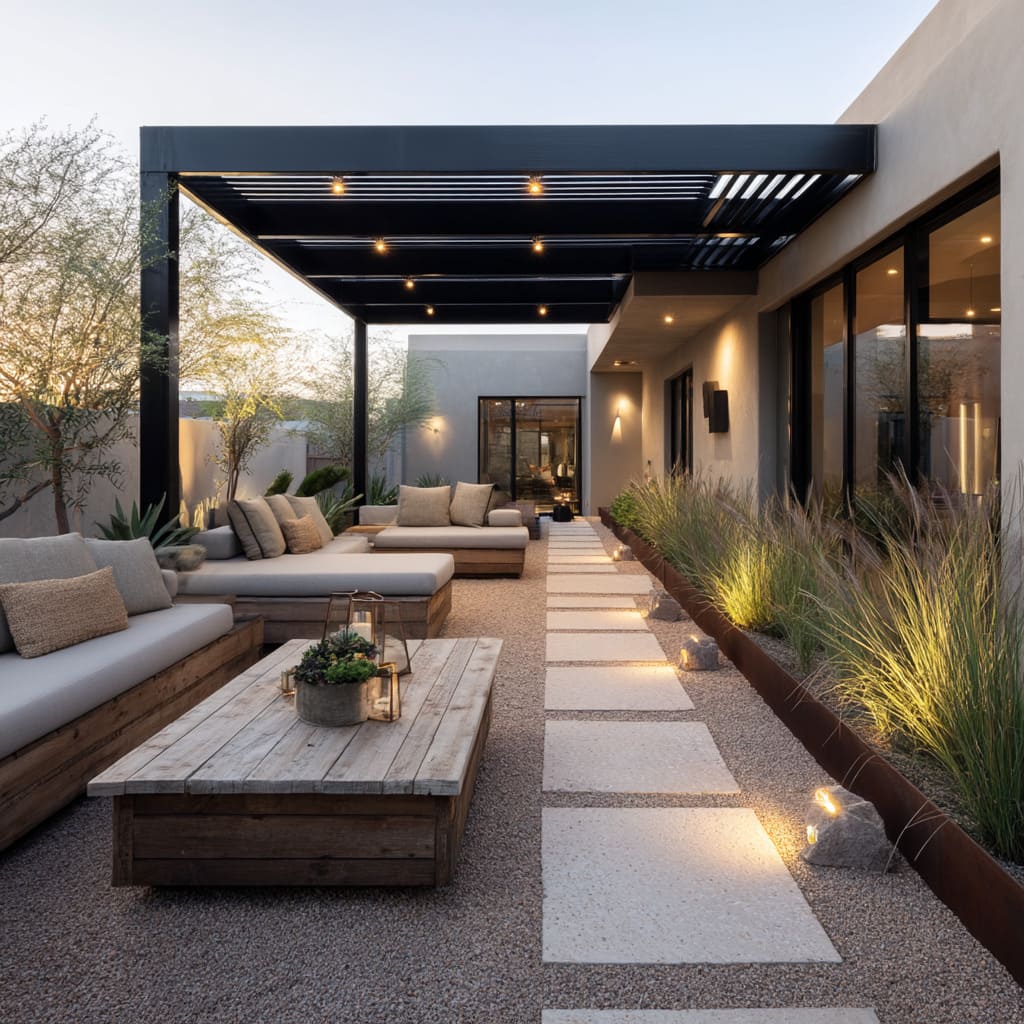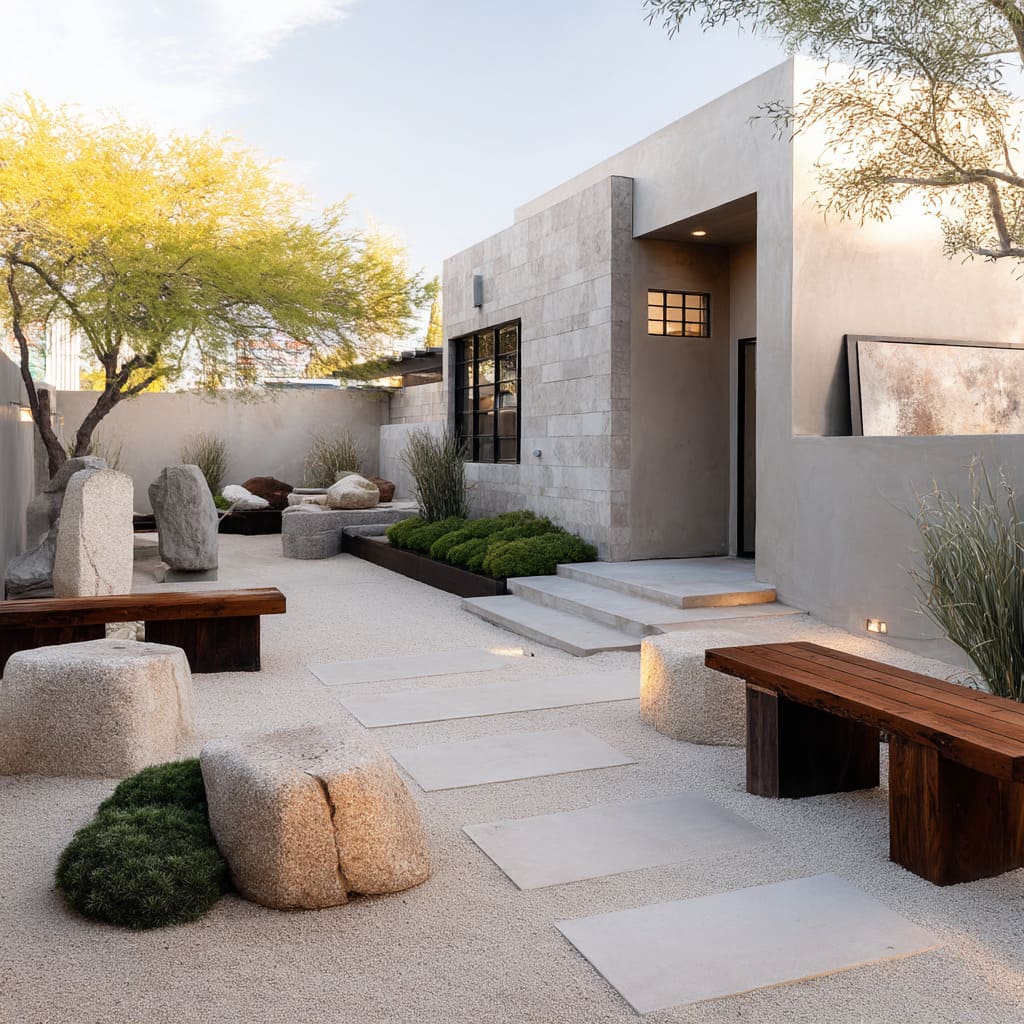Modern desert backyards today rely less on filling space and more on shaping perception. The strongest layouts aren’t crowded with features—they’re composed with restraint, where every curve, texture, and gap carries weight.
Today, visual structure takes priority over decoration. Concrete might hover rather than sit flat.
A cactus may be the only living element in sight, framed by shadows rather than blooms. The use of light, surface grain, and asymmetry builds a calm tension that gives each yard its own visual rhythm.
These outdoor environments speak through contrast—between fine gravel and smooth stone, between fixed lines and soft shadow movement. Instead of softening the desert, they work with it, using simplicity to draw attention to form, space, and time of day.
Curves Used to Soften Authority
Straight lines can make a desert yard feel static or overly structured—especially when paired with angular architecture. That’s where arcs, loops, and serpentine forms begin to matter.
Curves interrupt the dominance of right angles and help the layout feel more relaxed, without depending on dense vegetation. In many refined desert backyard landscape ideas, S-curves are used to guide the eye and shape walkways in subtle rhythms.
These shapes also shift how light interacts with the ground—bouncing gently, not sharply. Curved bench seating, rounded gravel fields, and concentric raking patterns don’t just suggest movement; they slow it down.
They invite stillness without freezing the space. And unlike bold focal points, these forms work quietly in the background, keeping the visual tone smooth and light.
Even hard materials like concrete or steel take on a softer presence when bent into arcs. This use of softened geometry isn’t decorative—it brings a sense of calm that doesn’t rely on shade or excess planting.
In desert settings, where the sun defines every line, curves are used to take the edge off.
Light as Architecture
In the most visually refined desert landscape ideas, light isn’t treated as a finishing touch—it’s part of the visual structure. Edge glow is one of the quietest techniques, where soft LED strips tucked below concrete benches or deck platforms help heavy elements appear to float.
The visual lift these strips provide changes the perceived weight of the material, making even poured concrete feel light on the ground.
Then there’s the role of shadow grids—a feature increasingly present in modern pergola designs. Thin beams, often aligned in open sequences, filter daylight into stripes that stretch and narrow as the sun shifts.
These changing bands act like a moving ceiling, bringing animation to otherwise static surfaces. A blank stucco wall becomes a play of light lines.
A tiled patio becomes a shifting pattern of texture.
At night, targeted uplighting quietly redraws the yard. Lights placed at the base of sculptural plants or stone features highlight form, not brightness.
A simple agave casts long shadows that stretch across gravel. A cactus row becomes a vertical silhouette against a dark backdrop.
These types of lighting don’t overpower—they sharpen the geometry and give the layout a second life after sunset. Used with control, they reinforce the structure of a space instead of decorating it.
In many high-end desert designs, light isn’t applied—it’s shaped.
Monochrome, Then Micro-Contrast
Color choices in many modern desert landscaping concepts aren’t driven by variety but by discipline. A clear tone is set—sometimes warm sand, sometimes cool ash, occasionally a darker clay—and it holds the visual field with quiet consistency.
That steady base allows the smallest shifts in tone or finish to carry more weight. A single burnt-orange pillow or a charcoal slate wall doesn’t clash—it becomes the main accent through isolation.
In these layouts, micro-contrasts are the key players.
Coarse gravel next to tightly packed fines, or matte stucco beside a stone polished just enough to catch light, create shifts that don’t rely on color at all. What changes isn’t the hue, but the texture, the grain, the way light lands and moves.
In some high-end desert garden ideas, even a slight sheen from satin concrete will pull the eye when everything else is flat and raw. This level of contrast isn’t loud—it works quietly by heightening sensitivity to surfaces and shadow.
Ground-Level Furniture Illusions
In many refined backyards, seating doesn’t appear as added furniture—it feels carved from the landscape itself. Long concrete benches poured flush with the patio, or walls that transition seamlessly into wide sitting ledges, create the sense that the seat was always meant to be part of the place.
These aren’t decorative extras. They’re integrated shapes—solid and low, echoing the horizontal lines of the desert horizon.
What softens them is carefully chosen padding: earth-toned cushions, often thick and weighty, that drop into the space without breaking its flow. Because the furniture hugs the ground, it doesn’t pull attention upward—it keeps the gaze at surface level, reinforcing the grounded feel that defines many modern desert landscaping styles.
The illusion works because of how well the seat belongs. It shares its texture with the walls.
It aligns with the pavers. And often, there’s no visible base or leg to disrupt the effect.
These seats are less about furnishing and more about shaping the space from within.
Plants as Punctuation, Not Paragraph
Planting in a desert landscape backyard often follows a principle of intent over abundance. Instead of broad beds layered with competing textures, the use of isolated or precisely repeated plant elements becomes a form of visual rhythm.
A single mesquite, a row of golden barrel cacti, or a tight agave trio can act like commas, colons, or full stops—breaking space into structured beats.
The planting doesn’t need to explain itself. It interrupts at just the right moment.
These living elements are placed not to fill space but to control it. Each species is chosen for shape and spacing, not lushness.
They echo the layout’s lines or press gently against them. In many landscaping ideas for desert, plants serve the composition the way punctuation serves writing—adding pause, direction, and balance without taking over the sentence.
This restraint forces attention onto form, allowing every leaf or spine to stand out as a visual object, not part of a backdrop.
Texture-Rich, Color-Quiet Hardscapes
In desert settings where color saturation can quickly overwhelm, many backyards let texture do the heavy lifting. You’ll often find a quiet but layered surface palette: weathered corten steel, with its natural rusted finish; raked decomposed granite, catching shadows between its ridges; untinted plaster, raw and sun-softened; or a canvas shade, stretched in tension but loose in feel.
These materials don’t scream—they hum.
The choice to keep tones quiet—ochre, sand, soot, or chalk—allows light and shadow to shape the experience. Grain becomes more important than pigment.
Soft or gritty, smooth or ridged, dry or slightly polished—each surface reflects desert light in its own way. The absence of bold color opens up space for subtle contrast: a pale paver beside a coarse gravel band, or a matte stucco plane interrupted by the deep lines of a concrete joint.
These textures don’t compete. They layer slowly, shaping depth not through brightness, but through how each material holds or releases light.
Optical Floating and Suspension
There’s a quiet drama in how mass can appear to defy gravity—especially in settings shaped by desert light. Many layouts in desert style landscaping use this to their advantage.
A concrete slab doesn’t simply rest on gravel; it appears to hover when separated by slim joints filled with black stone. That thin shadow line tricks the eye into seeing the object as lighter than it is.
Below-bench lighting takes the illusion further—casting a glow that visually lifts heavy surfaces off the ground, much like heat shimmer in open air.
Water platforms edged in dark materials push this effect even more: reflections blur the base, while darker frames help detach the platform from its surroundings. These touches don’t depend on complexity—they rely on spacing, contrast, and light control.
The overall impression feels intentional but quiet, as if these shapes were always meant to float. In the context of modern desert landscape ideas, the effect is less about showing off and more about how small shifts can completely change how weight is seen.
Framing Distant Views Internally
Even enclosed backyards can suggest openness—not by being wide, but by how they are shaped to look outward. It’s common to find curved walls or soft arcs holding and directing the sightline toward a tree, a horizon edge, or even a faraway mountain shape.
These lines act like visual channels, guiding the eye without needing to crowd the space. A small opening in a wall might align perfectly with a branching palo verde beyond the property.
A low loop of corten steel might bend in such a way that it visually hugs a distant cactus. These framing techniques allow the external environment to become part of the interior composition.
It’s a technique often overlooked in backyard planning but quietly powerful—especially in compact courtyards, where the temptation might be to close in. Instead, these gestures let the design breathe outward, making the space feel layered without adding more objects.
It’s a reminder that even in tight areas, placement of lines and forms can pull in more than they contain.
Asymmetry for Tension
Balance doesn’t always mean matching halves. In many desert layouts, asymmetry is used with precision to avoid stillness.
An oversized stone placed off-center, a planter that interrupts a perfectly even path, or a seating wall that tapers unexpectedly—these details are quiet but intentional. They introduce slight shifts in rhythm, which keeps the space from feeling frozen.
Asymmetry doesn’t create disorder—it activates the layout. In a desert back yard, even a single tree set off-axis can tilt the composition just enough to create visual pull.
Movement is implied, not in the function of the yard, but in how the eye reacts to it. Where everything is slightly too perfect, interest fades.
But where something small feels nudged out of place, the space feels alive. These deviations are subtle—they don’t overpower—but they hold tension in a way that perfectly balanced symmetry often can’t.
Day-to-Night Transformations
A desert yard landscape is shaped not just by form and texture, but by time. The best ones are made to shift with the light.
Materials are selected not just for how they look in full sun, but for how they respond after it drops. Pale stone that feels dry and cool at midday will start to glow softly under warm ground lighting.
Water features—minimal in shape—mirror the changing color of the sky and bounce back the last light of dusk.
Even rusted corten steel takes on new life after a light rain or with the soft gleam of a nearby lantern. These are spaces built to stay visible after dark—not through brightness, but through contrast.
Shadows grow sharper, outlines become more important than color, and hidden lights draw out detail that goes unnoticed during the day. The entire layout begins to shift.
Edges blur. The materials that defined the space under the sun now hold it together by reflecting fragments of night.
This duality is not an afterthought—it’s designed into the quiet drama of each line and surface.
Conclusion
What makes such desert outdoor designs feel complete isn’t how much they contain—it’s how carefully every element interacts. Light changes the tone of materials.
Lines pull the view outward or slow it down. Even a planted shape becomes part of the structure rather than an accessory.
These layouts aren’t built for variety—they’re built for clarity. By shaping tension, contrast, and restraint into the foundation, these spaces remain active under full sun or fading dusk.
The outcome is not about trend-chasing, but about crafting visual depth in the most minimal terms—where texture replaces decoration, and composition holds more presence than color.

